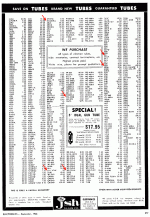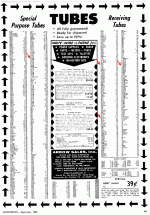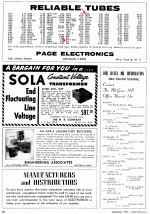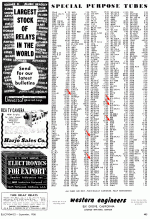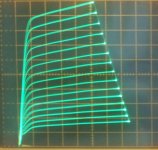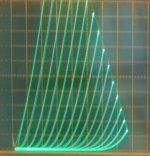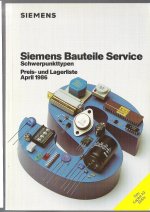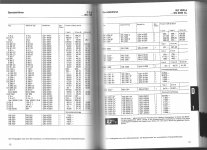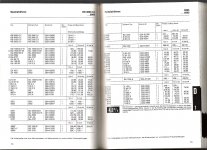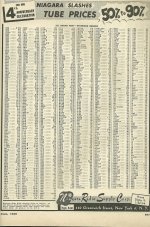ELECTRONICS Magazine, Sept 1956
Good prices on W.E. 300B!
Also some other tubes now not sold cheap.
Yes, $5 was worth more then, but note that a new VTVM cost $35-$82, a high-voltage probe $7. Actually, allowing for inflation, a $5 would be about $55 in today's smaller money. But clearly a bunch of these fine tubes were going out of style and the tube-mongers were clearing the stale goods out of the warehouse. I leave it to the smarter economists to figure if I should have bought-up all the 300Bs in 1956 as Investment. (I was very small and my folks just-about had $5 to feed my tiny growing body.)
Good prices on W.E. 300B!
Also some other tubes now not sold cheap.
Yes, $5 was worth more then, but note that a new VTVM cost $35-$82, a high-voltage probe $7. Actually, allowing for inflation, a $5 would be about $55 in today's smaller money. But clearly a bunch of these fine tubes were going out of style and the tube-mongers were clearing the stale goods out of the warehouse. I leave it to the smarter economists to figure if I should have bought-up all the 300Bs in 1956 as Investment. (I was very small and my folks just-about had $5 to feed my tiny growing body.)
Attachments
Still have a 1962 Allied catalog with Genalex KT-88 matched pairs for $12.00. If we were prescient, would we let things get this messed up? Tough call.
All good fortune,
Chris
All good fortune,
Chris
Yes, different times and different prices.
But please note how many tubes that are considered rare and useful today, against the huge number of types nobody uses these days.
I still find tube lots for sale where I live, and I have to shift thru the masses of tubes, to find the few useful ones.
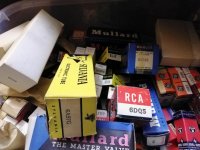
An odd Genelex KT 88 here, a few Mullard Ecc32 there, some 12AX7 but the rest of the tubes, 100's of kg' s and large numbers in dusy boxes is types of no use today.
But of course its fun to sift through, and fun to repair old tube gear when you have most of the tubes in stock.
But please note how many tubes that are considered rare and useful today, against the huge number of types nobody uses these days.
I still find tube lots for sale where I live, and I have to shift thru the masses of tubes, to find the few useful ones.

An odd Genelex KT 88 here, a few Mullard Ecc32 there, some 12AX7 but the rest of the tubes, 100's of kg' s and large numbers in dusy boxes is types of no use today.
But of course its fun to sift through, and fun to repair old tube gear when you have most of the tubes in stock.
Last edited:
Still some bargains around yet.
I got me a big box of GE JAN 6197 tubes last Spring when they were on sale for $0.33 in quantity. Very nice curves (below). Remarkably uniform.
Many remarkable tubes on the 9DX base are on the $1 list at ESRC yet.
I got me a big box of GE JAN 6197 tubes last Spring when they were on sale for $0.33 in quantity. Very nice curves (below). Remarkably uniform.
Many remarkable tubes on the 9DX base are on the $1 list at ESRC yet.
Attachments
Last edited:
You want to cry? Find a Glass Audio magazine from the early-mid ‘90s and see what NOS tubes sold for jut before the tube bandwagon got really rolling.
In 1963, workers earned $2.20 per hour.
The 1962 $12 per matched pair of KT88 tubes cost you 5.45 hours.
In 2019, workers earn about $14 per hour.
A good $83 matched pair of KT88 tubes costs you 5.92 hours.
But tax rates are higher today than in 1963, so the tubes are slightly more expensive (but not enough to make you cry).
The 1962 $12 per matched pair of KT88 tubes cost you 5.45 hours.
In 2019, workers earn about $14 per hour.
A good $83 matched pair of KT88 tubes costs you 5.92 hours.
But tax rates are higher today than in 1963, so the tubes are slightly more expensive (but not enough to make you cry).
Last edited:
Not from 1956, but I found a Siemens catalog from 1986, still listing "Weitverkehrsroehren", the German "Amtsdeutsch" for thermionic valves for telecommunication i.e. state-owned PTT service. Prices are in DM Deutsche Mark. The US$ was DM2,17 in April 1986, and a 1986 $ is about $2,35 by today's value. So you can take the DM prices as today's US$, roughly ...
Attachments
Tube 6197 in triode X=?V Y=?ma Vg=?step
https://www.diyaudio.com/forums/tub...2p-triode-7788-triode-curves.html#post5976975
If the price of tubes includes free, I cant remember paying anything for tubes in the 60's or '70s. Must have been all those cheap prices from the 50's.
When I was a kid, our next door neighbor ran a private TV repair shop in their basement and that fellow gave me the guts of some GE console - just the two chassis, but populated. I used to invite my friend's over to watch me burn up small speaker voice coils, when I turned it all the way up. It had 4 6V6s in one chassis; two of which I could never figure out what they did. At the other end of an umbilical was the tuner/preamp.
In my late teens a friend's father had a Marantz 7, a Dynaco MKIII and an AR3 speaker. One day he just up and gave me the Marantz 7. I remember using it in my room, hooked up to an AR turntable. After giving it a good thrashing - not knowing what it was nor being anywhere near ready for it - I let it go after several years of unused ownership - for a song.
My father had things around that were tube based, which included the family SE, 4 Tube, AC/DC Stereo amplifier connected to a turntable with a crystal stereo cartridge. Diamond stylus, it worked on the beatles white album. Would have worked a lot better if I had my 15" Lii Audio FR speakers back then. We had a few different tube based TVs, into the color era. I'd just gaze inside when my dad removed the back cover.
Back then I knew of no one with a high end stereo as we practice here, until one time my friend invited me to smoke a joint over at his father's apartment. My friend opens the doors to a closet space and inside are AR3a's, a pair of of MKIII's, a PAT3 preamp and some benjamin miracord turntable. I dont remember what he played, but I do remember the sound being so liquid and the bass - my gosh the bass had the lowest, smoothest, most rounded pure tone I ever heard. Nothing but distortion in those low frequencies was my whole life's conditioning. What an impressive sounding setup this guy's father had. A great experience to have had with what tube equipment can do.
So if you lived back in those days, had a little luck, fortune and serendipity with this stuff, you were probably rolling in it for little if any cost due to the sheer abundance. And with solid-state coming onboard, lots of tube-based equipment churn around the time - well before most of the stuff ever made had been collected up.
When I was a kid, our next door neighbor ran a private TV repair shop in their basement and that fellow gave me the guts of some GE console - just the two chassis, but populated. I used to invite my friend's over to watch me burn up small speaker voice coils, when I turned it all the way up. It had 4 6V6s in one chassis; two of which I could never figure out what they did. At the other end of an umbilical was the tuner/preamp.
In my late teens a friend's father had a Marantz 7, a Dynaco MKIII and an AR3 speaker. One day he just up and gave me the Marantz 7. I remember using it in my room, hooked up to an AR turntable. After giving it a good thrashing - not knowing what it was nor being anywhere near ready for it - I let it go after several years of unused ownership - for a song.
My father had things around that were tube based, which included the family SE, 4 Tube, AC/DC Stereo amplifier connected to a turntable with a crystal stereo cartridge. Diamond stylus, it worked on the beatles white album. Would have worked a lot better if I had my 15" Lii Audio FR speakers back then. We had a few different tube based TVs, into the color era. I'd just gaze inside when my dad removed the back cover.
Back then I knew of no one with a high end stereo as we practice here, until one time my friend invited me to smoke a joint over at his father's apartment. My friend opens the doors to a closet space and inside are AR3a's, a pair of of MKIII's, a PAT3 preamp and some benjamin miracord turntable. I dont remember what he played, but I do remember the sound being so liquid and the bass - my gosh the bass had the lowest, smoothest, most rounded pure tone I ever heard. Nothing but distortion in those low frequencies was my whole life's conditioning. What an impressive sounding setup this guy's father had. A great experience to have had with what tube equipment can do.
So if you lived back in those days, had a little luck, fortune and serendipity with this stuff, you were probably rolling in it for little if any cost due to the sheer abundance. And with solid-state coming onboard, lots of tube-based equipment churn around the time - well before most of the stuff ever made had been collected up.
In 1963, workers earned $2.20 per hour.
The 1962 $12 per matched pair of KT88 tubes cost you 5.45 hours.
In 2019, workers earn about $14 per hour.
A good $83 matched pair of KT88 tubes costs you 5.92 hours.
But tax rates are higher today than in 1963, so the tubes are slightly more expensive (but not enough to make you cry).
In the US, median worker makes a bit more than $30/hr. (Starting wage at McDonalds in rural PA is $13/hr.)
Even with their recent prices, stocks were a better investment than tubes.
In rural south GA, McD's and entry level clerk-type positions are in the $7-9/hr range. But, the cost of living down here is pretty reasonable.
US Bureau of Labor Statistics shows Q3 2019 median weekly income for the US at $919 for a 40-hour week, so ~ $23/hr
My bad, was thinking of family income:
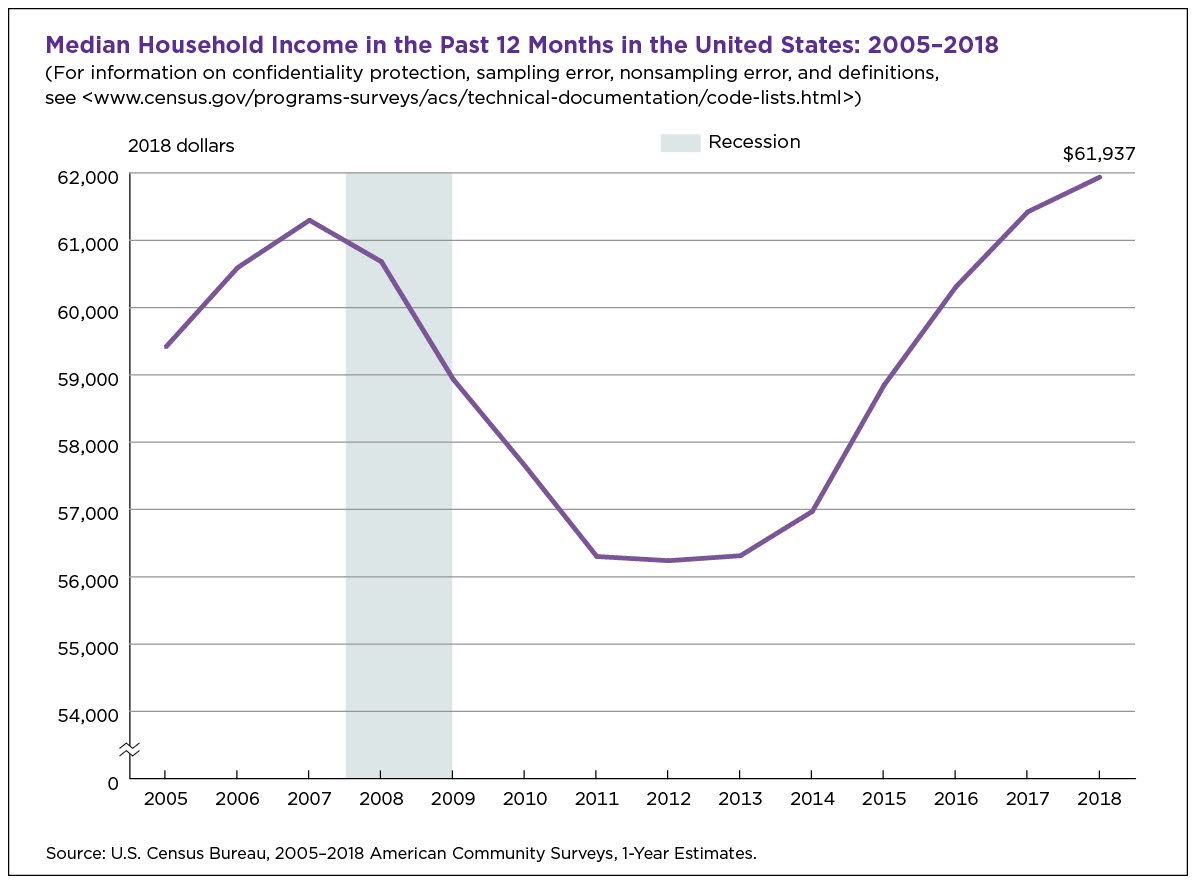
- Home
- Amplifiers
- Tubes / Valves
- Tube prices - 1956
